A Comprehensive Guide to Skate Paint for Custom Boards
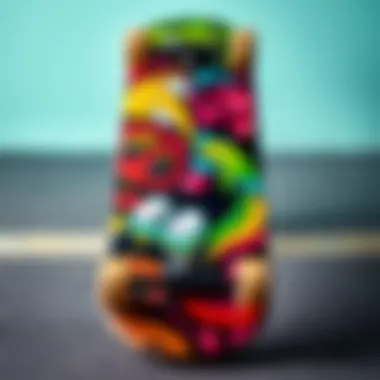
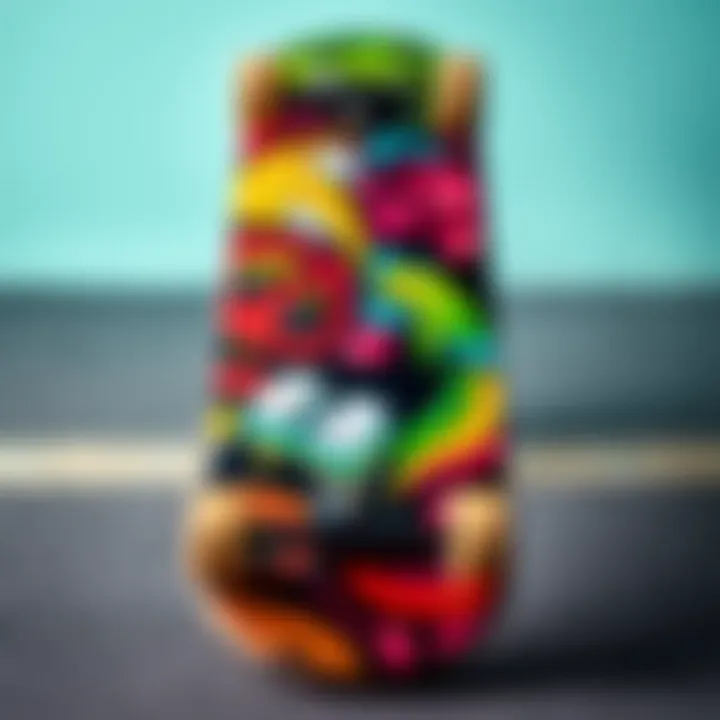
Intro
Skateboarding isn't just a sport; it's a full-blown culture drenched in creativity and self-expression. At the heart of this vibrant community lies an often-overlooked element: skate paint. This specialized paint allows skateboard enthusiasts to transform their blank boards into striking canvases, showcasing individuality and flair. Whether you're a seasoned pro or just starting out, understanding the inner workings of skate paint will greatly enhance your custom designs.
In this article, we’ll delve into the world of skate paint, examining its key materials, application techniques, and overall durability. Beyond that, we'll discuss practical tips to help avoid common pitfalls as you navigate your artistic journey. And to top it all off, comparisons of various brands will provide insight into popularity and performance, ensuring you pick the right tools for your creative needs. So, strap in and prepare to explore the fascinating nuances of skate paint!
Prologue to Skate Paint
Skate paint serves as more than just a tool for aesthetic enhancement; it is the very fabric that weaves identity into the skateboarding community. As riders carve the streets, each board tells a story through the art meticulously applied to its surface. One might wonder, what makes skate paint critical for both the artist and the skater? The answer lies in its multifaceted role in self-expression, creativity, and performance.
Definition and Importance
At its core, skate paint is a specialized medium designed specifically for customizing skateboards. Unlike standard paints, skate paint is engineered to withstand the harsh realities of riding. The importance of skate paint cannot be overstated. It affects not only the visual appeal of the skateboard but also the overall experience of riding it. Properly applied paint not only keeps skaters from slipping but also allows them to convey their personality and creativity.
In practical terms, the definition of skate paint relates to its formulation: flexible, durable, and often waterproof. Such characteristics are crucial because a skateboard isn’t merely an artistic canvas; it’s a tool for both art and athleticism. For instance, classic painters might use oils to depict landscapes but for those in the skate world, quality paint is paramount for both style and function. Without good paint, vibrant designs quickly fade or wear off, leading to a loss of that carefully crafted identity.
The Role of Art in Skate Culture
Art plays an integral role in skate culture, making it a living, breathing expression of individuality. Each skateboard can be viewed as a blank canvas, where the paint transforms it from a simple plank of wood into a mobile piece of art. This transformation isn’t made just in the design but through the stories it tells, reflecting the personality of the skater.
The skateboarding community thrives on this connection between art and movement. The imagery often gracing a skateboard deck—street art motifs, abstract graphics, or even intricate portraits—serves to initiate conversations. They can symbolize rebellion, freedom, or unparalleled creativity. Artists often draw inspiration from their surroundings, turning the mundane into something extraordinary.
When a skater zips by, it’s not just about the tricks; it’s also about the way their board represents their ethos and aesthetic. As they soar or grind, the image on the board is a testament to the skater's journey and their voice within the collective culture. For many, skateboarding isn’t just a pastime; it’s a way of life that intertwines art, sport, and self-expression.
Understanding Skate Paint Materials
When it comes to decking out your skateboard, the choice of paint isn’t just a matter of color. The materials used play a pivotal role in the overall performance and longevity of your artwork. Understanding skate paint materials can help enthusiasts make informed decisions that elevate their custom designs and ensure they hold up under wear and tear. By diving into the specifics, skateboard artists can achieve long-lasting, vibrant expressions of their personalities on their boards.
Types of Paints Used
Different types of paints cater to various styles and application methods, each storing its unique set of characteristics beneficial for skateboard art. Below are the primary categories:
Acrylic Paint
Acrylic paint shines in the realm of skate paint for its versatility. It’s a water-based medium that dries quickly and provides a flexible finish, making it ideal for applications that might face bending or flexing due to the nature of a skateboard.
Key Characteristics: It’s known for its vibrant colors that stand out and also its ease of use. Acrylics can be thinned with water, allowing for a range of techniques from washes to solid layers.
Advantages: One significant feature is how easily it can be cleaned with water when wet, making any touch-ups a breeze. Plus, once dry, it's permanent and holds well against scratches more than other paints might.
Disadvantages: However, this type of paint can be susceptible to UV light, leading to fading over time. This means skateboarders might need to consider a protective layer or sealant if their boards are often exposed to the sun.
Spray Paint
For those looking to cover larger areas or create soft gradients, spray paint comes into play. Its application method allows for quick and even coverage, ideal for base coats or dynamic backgrounds.
Key Characteristics: Spray paint offers a variety of finishes, from matte to glossy, which makes it a popular choice among street artists and skaters alike looking to make bold statements.
Advantages: One of its unique features is the ability to control the spray technique, resulting in myriad effects, from thin lines to thick coats. The drying time is relatively short, enabling artists to layer quickly.
Disadvantages: Despite these benefits, overspray can be a nuisance, often requiring careful masking to prevent unintentional marks. Additionally, the fumes can be quite potent, necessitating proper ventilation during application.
Marker Paint
Marker paint, another essential tool for skateboard customization, is a great way to add fine details or touch-ups to designs. These pens come with various tips, allowing for precision that brushes may not always afford.
Key Characteristics: They’re often filled with acrylic paint, ensuring they bond well with various surfaces, including wood and plastic.
Advantages: A distinct advantage of marker paint is convenience. It’s portable, requiring no mixing or preparation, making it an excellent choice for quick designs or spontaneous ideas.
Disadvantages: However, marker paints may not hold up as well under heavy wear compared to sprays or traditional paints, making them better suited for artwork that won't see excessive use or scrutiny.
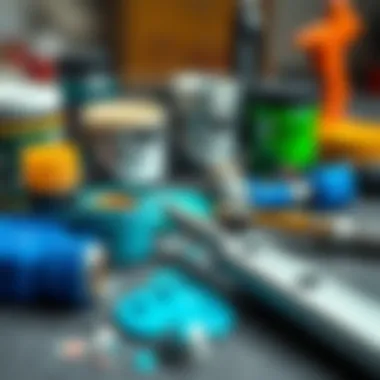
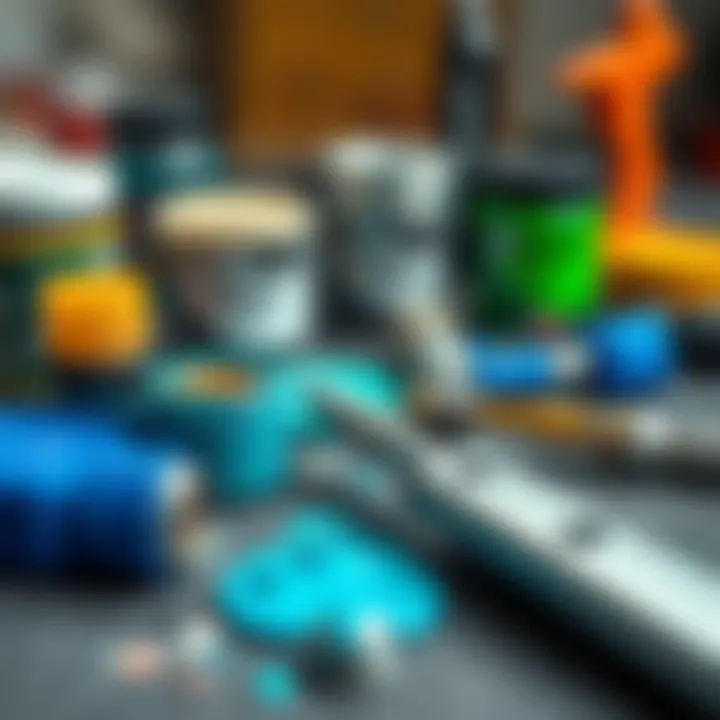
Binding Agents and Additives
Apart from the paint type, the binding agents and additives play an essential role. These ingredients determine the paint's adhesion, durability, and resistance to elements. For instance, certain additives enhance water resistance, which is crucial for skaters who ride in various weather conditions. Other factors include ensuring that the paints can bond to surfaces like grip tape or wood, allowing a strong hold that withstands impacts.
In summary, understanding the materials behind skate paint is vital. It influences not just the final visual but also the resilience of the artistry against the rigors of skating. Several elements come into play, making it imperative for artists to weigh their options carefully to achieve the desired results.
Application Techniques
The art of using skate paint goes way beyond just slapping some color on a board. It involves a series of carefully executed application techniques that can make or break your custom design. These techniques not only enhance aesthetics but also ensure durability and longevity of your artwork. Whether you’re a seasoned pro or a newbie with a can of spray paint, understanding how to apply your paint correctly is vital for your creative expression.
Surface Preparation
Preparation is half the battle when it comes to painting. A clean and smooth surface lays the groundwork for excellent adhesion and ultimately, a better finish. Skaters starting from scratch often overlook this step, thinking they can go straight into the artwork. However, a well-prepared surface can make you able to achieve much more polished and professional results.
To begin, you should clean the board thoroughly to remove dirt, grime, and any old paint residues. Using a simple mixture of mild soap and water often does the trick. After cleaning, drying the board is essential. If you're in a humid area, or if the board was recently wet, it’s tempting to jump to painting. Resist that urge. A damp surface can ruin your finish. Once the board is dry, sanding it lightly with fine-grit sandpaper can help create texture, allowing the paint to adhere better.
Layering Techniques
Layering is key to achieving depth and subtlety in your designs. Jumping into one thick coat usually doesn’t give the desired outcome. Instead, working in layers will enable you to build complexity and versatility in color.
Base Coat
The base coat is like the foundation of a house; it needs to be strong and reliable. It's usually a solid, more neutral color that sets the stage for everything that follows. Using a base coat not only helps colors pop later but also keeps darker pigments from bleeding through lighter ones.
The key characteristic of a good base coat is its ability to go on evenly and smoothly. Products like Krylon ColorMaster Paint are popular here for their fine spray and quick-drying properties. However, not all base coats are created equal. Some might require mixing or more drying time due to their specific properties.
Detailing
Once the base coat is settled, detailing comes into play. This is where the unique touches and personalized flair really shine through. Detailing can involve anything from simple lines to intricate designs. This step is crucial for making your skate art truly yours.
The beauty of detailing is in its flexibility; you can use thin brushes or even markers designed for art to achieve precise results. Many skaters swear by Posca markers for this layer due to their vibrant colors and versatility. However, they may also run the risk of smudging if not allowed to dry properly, so take your time.
Finishing Coats
Finishing coats are where the protective magic happens. These layers can add luster and robustness to your creation while safeguarding it against the elements. A good finishing coat locks in colors and delivers that glossy appearance that makes skateboards dazzle in the sunlight.
The unique feature of a quality finishing coat is its ability to repel water and shield against daily scrapes. One popular choice among artists is Rust-Oleum Clear Enamel because it provides excellent weather resistance. However, be cautious, as over-application can lead to runs in the paint that can ruin a meticulously crafted design.
Tools for Application
The right tools are just as important as the paint itself. They determine the precision and quality of your work.
Brushes
When it comes to brushes, you want to pick ones that provide control over your strokes. Flat brushes can cover large areas quickly, while finer brushes are ideal for detailed work. Synthetic brushes are generally preferred because they’re more durable and hold their shape better. Furthermore, you may find that a Filbert brush is a perfect tool for softer edges in your designs. However, make sure to maintain your brushes well, as dried paint can ruin their effectiveness.
Spray Nozzles
Using the right spray nozzle can greatly affect your application technique. Fine tips allow for highly detailed work, while wider nozzles are great for broader strokes. Many users prefer the versatility of adjustable nozzles, enabling them to switch between precision and coverage with ease. However, keep in mind that it might take some time to find the best nozzle that matches your painting style.
Stencils
Stencils are a lifesaver for achieving precise designs quickly. These handy tools come in various shapes and sizes, giving you the freedom to replicate intricate patterns with ease. A unique feature of using stencils is that they offer a uniformity that can be harder to achieve by hand, especially for designs requiring symmetry. Yet, they often don’t flow as seamlessly into the overall artwork, leading to hard lines that can look out of place unless thoughtfully incorporated.
Painting your skateboard can be a rewarding endeavor, blending art with personal expression. Mastering these application techniques is essential for entering that colorful world where creativity meets the thrill of skating.
"Preparation and layering are the unsung heroes of skate paint application."
Understanding these principles can mean the difference between a mediocre piece and something that stands out in the skate community.
Evaluating Durability and Performance
When venturing into the world of skate paint, one cannot overlook the significance of durability and performance. Esthetics aside, a skateboarder desires coatings that not only look good but perform well under the rigorous demands of skating. As the wheels hit the pavement, the paint faces an onslaught of wear—from tricks and grinds to various weather conditions. Evaluating these qualities can help artists choose the right materials, ensuring their designs remain vibrant and intact, even after countless rides. Let's dive deeper into the specifics.
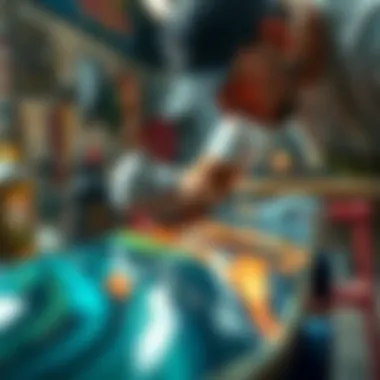
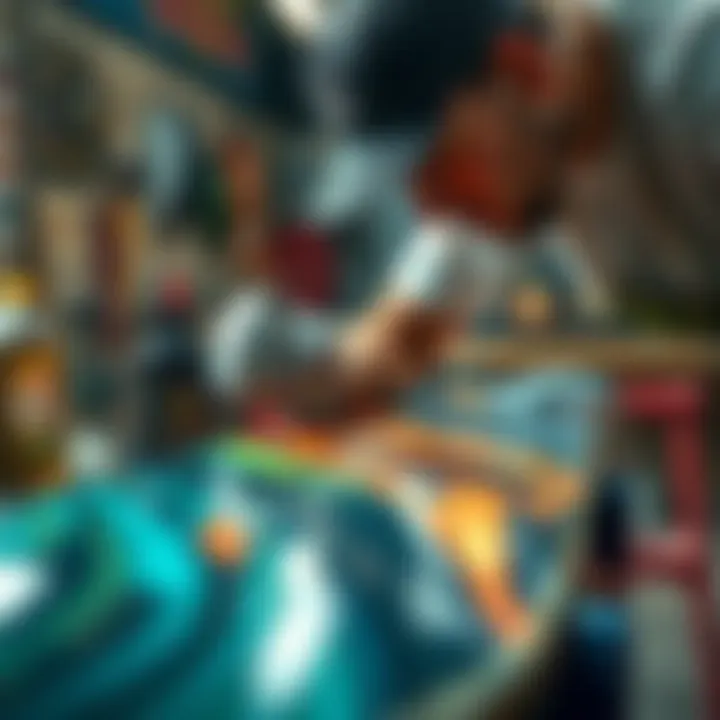
Resistance to Wear and Tear
Skateboards are often subjected to rough treatment. The surface can get scuffed while performing tricks, or it might chip when sliding on railings. Thus, the resistance to wear and tear of skate paint is crucial. A high-quality paint should withstand these stresses without losing its appeal.
Some notable features that help with this resilience include:
- Durable Formulations: Paints that contain specialized polymers often offer great resistance to scratches and scuffs.
- Surface Adhesion: Paint that bonds well to the skateboard surface will remain intact longer, even in the face of aggressive use.
Think about it: a skateboard artist puts a lot of time and effort into their designs, only to see them wear away after a few rides. Therefore, investing in a type of paint known for its durability is not just smart; it's essential.
Impact Resistance
Another focal point is impact resistance. Skateboards are frequently dropped, hit, and thrown about. A board that appears beautifully painted but crumbles under physical pressure is of little use to a dedicated rider.
Key aspects to consider include:
- Flexibility of Paint: Flexible paint formulas can absorb shocks better without cracking.
- Layer Thickness: Applying multiple layers, while ensuring they adhere together, can also enhance the resistance to impacts.
A skateboarder's peace of mind should come from knowing that their artwork doesn't just look good; it can handle a bit of rough and tumble.
Weather Resistance
Weather can throw a wrench in the works of any skateboard artist's masterpiece. If you want your designs to stand the test of time, both UV protection and water resistance are worth exploring.
UV Protection
Fading due to sunlight can be a significant drawback for painted skateboards. UV protection is a sought-after feature that guards against the harmful rays of the sun.
Saying that UV protection is important is an understatement. Here’s why:
- Color Retention: Paints with UV blockers maintain their hue longer, ensuring colors don't wash out.
- Longevity: This type of protection extends the lifespan of the paint, allowing skaters to enjoy their designs for much longer.
So, if you aim to preserve your artistic expression, UV protection becomes not just an option but a necessity.
Water Resistance
Moisture and paint don’t always get along. Water resistance is vital, especially for those who might skate in unpredictable weather or over wet surfaces.
The benefits of water resistance include:
- Preventing Peel-off: Water-resistant paints help keep layers intact by preventing them from lifting.
- Ease of Cleaning: For those that accidentally take their boards through rain puddles, the right paint allows for easier cleaning-up without compromising the design.
In the end, when it comes to durability and performance, the right skate paint can make or break your creative spirit on the streets. Investing time and thought into selecting materials that can withstand the rigors of skating will translate into a more vibrant and lasting expression of artistry.
Brand Comparisons
In the ever-evolving world of skate paint, the selection of brands can make or break your artistic adventure. Comparing different brands plays a vital role in understanding which products offer the best results, longevity, and value. By examining various options, skaters can find the right paint that reflects their style and withstands the demands of skateboarding. Brand comparisons not only reveal performance metrics but also showcase consumer satisfaction and brand loyalty, which can greatly influence one’s choice.
Top Skate Paint Brands Reviewed
Brand A: Overview and Insights
Brand A has carved a niche in the competitive skate paint market, particularly due to its vibrant color palette and excellent coverage. Known for its user-friendly application, skaters often reach for Brand A when they want dependable results without hours of prep work. One of its standout features is the quick-drying formula that allows skaters to hit the ramps shortly after painting. This characteristic makes it especially appealing for those who live life at full speed.
However, while the color selection is enviable, there have been mixed feelings regarding its scratch resistance. Some users have claimed that it wears down quicker than other premium brands, which is perhaps something to consider when making your choice.
Brand B: User Feedback
Brand B enjoys a loyal following, backed by rave reviews from users across various forums. Users often highlight that its matte finish provides an old-school look that resonates well with purists. A unique feature of Brand B is its eco-friendly formula, presenting a safer alternative for the environment and for artists working with it. The feedback reveals that many skaters appreciate the ability to blend colors effectively, allowing for custom designs without losing vibrancy.
Nevertheless, some users have reported that its drying time is notably longer than other brands. While this might be a drawback for those eager to paint and skate quickly, it offers the advantage of blending more effortlessly, adding an artistic edge to your design.
Brand C: Value Analysis
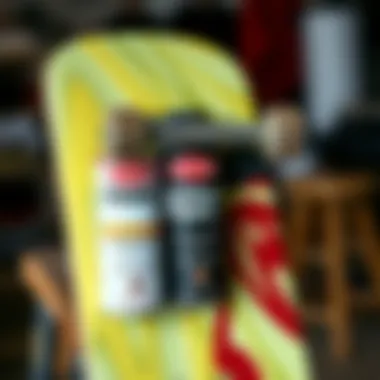
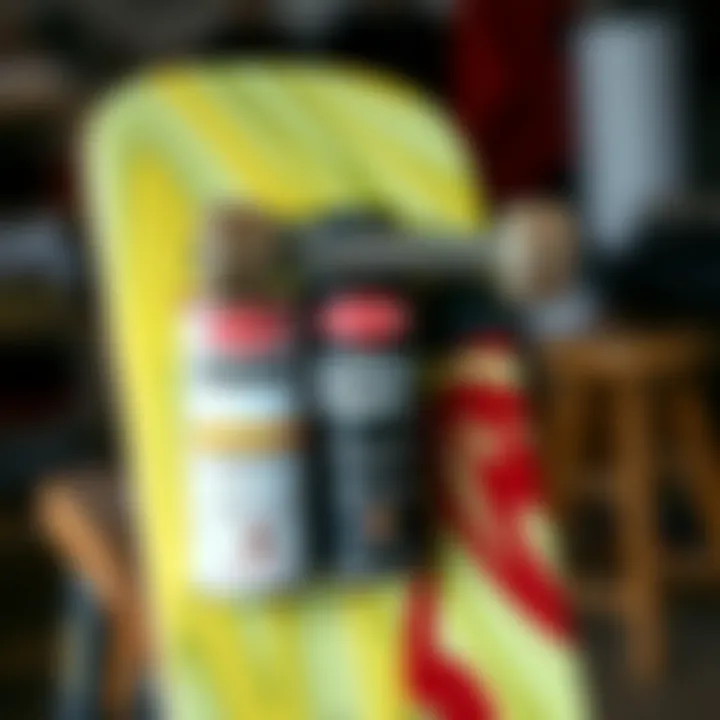
Brand C stands out in terms of affordability without compromising quality, making it an attractive option for beginners and seasoned skaters alike. Its robust additives allow for sturdiness against environmental elements, which is crucial for outdoor skaters. Feedback from users indicates that while Brand C might not have the broadest range of colors, the consistency and reliability it offers are noteworthy.
The unique selling point of Brand C is its exceptional value for money; many skaters find it to be a smart choice, balancing performance with budget. That said, it may not produce the same level of high-end finishes as pricier alternatives, which could deter serious artists looking for gallery-ready results.
Price vs. Quality Assessment
When it comes to selecting skate paint, the delicate dance between price and quality cannot be ignored. It’s essential to weigh the options carefully. Some brands may come at a premium, but they often offer superior features, durability, and color range. On the other hand, budget-friendly options typically deliver satisfactory results for casual users but might lack the high performance found in more established brands.
In summary, the key to finding the right skate paint lies in understanding your personal needs: whether you're a weekend warrior or an avid skater pursuing perfection, there lies a brand suited specifically to help you express your creativity on your board.
User Experiences and Testimonials
When it comes to skate paint, user experiences and testimonials play a crucial role in shaping the understanding of its capabilities and limitations. They provide a window into the real-life applications of various products and techniques, guiding both beginners and seasoned skaters in their journeys of creativity and self-expression. Feedback from users encapsulates what works best, shares tips born from trial and error, and highlights potential pitfalls to avoid. Through these narratives, a community is built, and a shared understanding of skate culture is fostered, which is invaluable for anyone looking to dive into the world of customizing skateboards.
Positive Feedback
Many skate enthusiasts rave about the diverse experiences they have had with skate paints. Reviews often reveal a few striking themes. One common point of appreciation is the vibrant colors that come alive with various brands. Users note how the hues can transform a plain skateboard into an eye-catching piece of art, helping skaters stand out from the crowd. For instance, using Acrylic Paint allows many artists to mix and match colors easily, creating custom shades that truly reflect their personality.
Another positive aspect frequently mentioned involves the easy application process of certain paints. Many skaters appreciate systems that allow for quick reapplication or touch-ups, especially after a good session on the grind. Brands praised for smooth layering and excellent flow often receive repeated mentions. Additionally, durability is a well-loved feature; users have lauded paints that withstand the rigors of skateboarding while maintaining their vibrancy over time. Positive testimonials often echo a resounding sentiment: the right skate paint encourages creativity and ownership of one’s board, making it not just equipment but an extension of the skater’s identity.
Common Issues Faced
While there’s plenty of praise to go around, user testimonials also illuminate some challenges. One frequently encountered issue is chipping. No matter how high-quality the paint may be, the harsh reality of grinding tricks can wear it down faster than anticipated. Skaters often find themselves grappling with not just aesthetic dilemmas but practical ones as well, as a chipped design may undermine the artwork initially intended for the board.
Another common complaint revolves around the drying time and the odor associated with some paints. While user preferences can vary widely, many express that they wish for quicker-drying options that do not release overwhelming fumes. This issue can often push skaters to find a balance between application time and paint relocation. Lastly, some brands have faced scrutiny due to insufficient adhesion to certain skateboard surfaces, which can lead to uneven application or peeling. This underscores the importance of proper surface preparation discussed earlier in the article—it’s not just about the paint, it’s also about how well it's applied that can make or break the experience.
"Skate painting isn’t just about colors—it's about telling a story. Each piece evolves through every trick. But boy, the time spent waiting for proper drying can challenge anyone's patience!"
Through sharing these narratives, users contribute to a rich tapestry of insights where both positive experiences and challenges faced become equally valuable learning opportunities for the skate community, helping everyone elevate their game while exploring the world of skate paint.
Best Practices for Maintenance
Maintaining your skateboard's paint job is not just about aesthetics; it's essential for ensuring longevity and protecting your investment. Engaging in proper maintenance practices enhances the overall experience of boarding and keeps your graphics looking fresh. Plus, it reflects the pride and care you take in your gear. Here, we delve into why maintenance matters and how you can excel at it.
Cleaning and Upkeep
When it comes to cleaning, think of your skateboard as more than just a mode of transport; it’s an expressive medium. Keeping it clean is fundamental to preserving the vibrancy of your skateboard paint. Depending on where and how often you ride, dirt and grime can accumulate, dulling colors and making your artwork less striking.
- Use Gentle Cleaners: Opt for a mild soap and warm water solution rather than harsh chemicals. These could damage the paint or coatings on your skateboard. A soft cloth can do wonders for removing surface dirt.
- Avoid Abrasive Tools: Steer clear of rough scrubbing pads or brushes. These can scratch the surface, leading to paint wear or peeling.
- Rinse and Dry: After cleaning, rinse off any soap residue thoroughly. The last thing you want is soap left on your board for a day at the skate park. Pat it dry instead of letting it air dry, which could lead to water spots.
Maintaining your skateboard is like keeping a good surfboard—it's about ride quality and shows off your dedication to your craft.
- Frequent Inspections: Regularly check for chips or scratches. Addressing these sooner rather than later can help you avoid larger issues down the line. If you spot a problem, consider touch-up paint specifically designed for skateboards to keep it looking its best.
Storage Recommendations
Proper storage is equally important as cleaning when it comes to extending the life of your skateboard, especially the artistic elements on it. Place it in a safe, dry spot away from direct sunlight—prolonged exposure can fade colors.
- Indoor Versus Outdoor: If possible, store your board indoors. High moisture and extreme heat can warp or compromise the integrity of both the board and the paint.
- Avoid Stacking: If you have multiple boards, avoid stacking them directly on top of each other. This can lead to scratches or dents. Instead, consider using wall mounts or a display rack.
- Temperature Control: Store your skateboard in a stable environment. Extreme temperature fluctuations can affect both the wood and the paint, leading to cracks and peeling over time.
- Use a Cover: When you’re not riding, consider using a cloth to cover your board. This helps prevent dust and grime from settling in.
Taking these maintenance tips to heart can significantly enhance your experience and the aesthetics of your skateboard. A well-cared-for board is also a conversation starter and a reflection of your individual style, adding personality to your skating experience.
For more resources on skateboard care, check out Skate Warehouse or browse through articles on Reddit. They often provide firsthand advice from fellow skaters.
Epilogue
In closing, this exploration of skate paint offers valuable insights into an often-overlooked aspect of skateboarding culture. Skate paint is not just a means of decoration; it plays a critical role in personal expression. When individuals customize their skateboards, they infuse a part of themselves into the art. This connection fuses the aesthetics of the board with the identity of the skater, amplifying the overall experience of riding.
Final Thoughts on Skate Paint
To truly appreciate skate paint, one must consider the myriad materials and techniques detailed throughout this article. The process of selecting the right type of paint—be it acrylic, spray, or marker—has profound implications on both durability and the artistic end result. As discussed, understanding the specific properties of these materials aids in achieving not only a visually stunning finish but also one that withstands the rigors of daily use. Skaters who invest time in learning about surface preparation and layering techniques ultimately find themselves more satisfied with their creations, allowing them to represent their unique styles vividly.
Moreover, it’s crucial to weigh brand choices and user experiences. Knowing the pros and cons of different skate paint brands can lead to informed decisions, ensuring that skaters don’t wind up with products that underperform or fall short of expectations.
Encouraging Creativity Within the Skate Community
The skateboarding community thrives on creativity and individuality. Each board painted with personal flair tells a story, and encourages others to express themselves, too. When skaters share their artistic endeavors—whether in local skate parks or on social media platforms like Reddit and Instagram—it fosters an environment where creativity can flourish. Initiatives such as skate paint workshops or online tutorials can further ignite the passion within the community, inspiring newcomers and veterans alike to explore this art form.
In essence, skate painting transcends mere graphics or colors splashed on wood. It’s a heartfelt message, a movement that pushes against the ordinary. By nurturing this spirit, skateboarders can transform not only their boards but the entire culture they are part of.







